Melville I (Destroyer Tender No. 2)
1915–1947
The first U.S. Navy ship named for George Wallace Melville, born in New York City on 10 January 1841 to Alexander and Sarah D. (Wallace) Melville, and the grandson of James Melville, who emigrated from Scotland in 1804. “Sometimes gruff and irascible,” the Dictionary of American Biography describes Melville, “he possessed a dauntless and masterful spirit, which suited his massive frame, leonine head, and great dome-like forehead.” Melville attended the Brooklyn Collegiate and Polytechnic Institute, and from there the engineering works of James Binns of East Brooklyn, N.Y. He entered the U.S. Navy on 29 July 1861, as an officer of the Engineer Corps with the rank of Third Assistant Engineer.
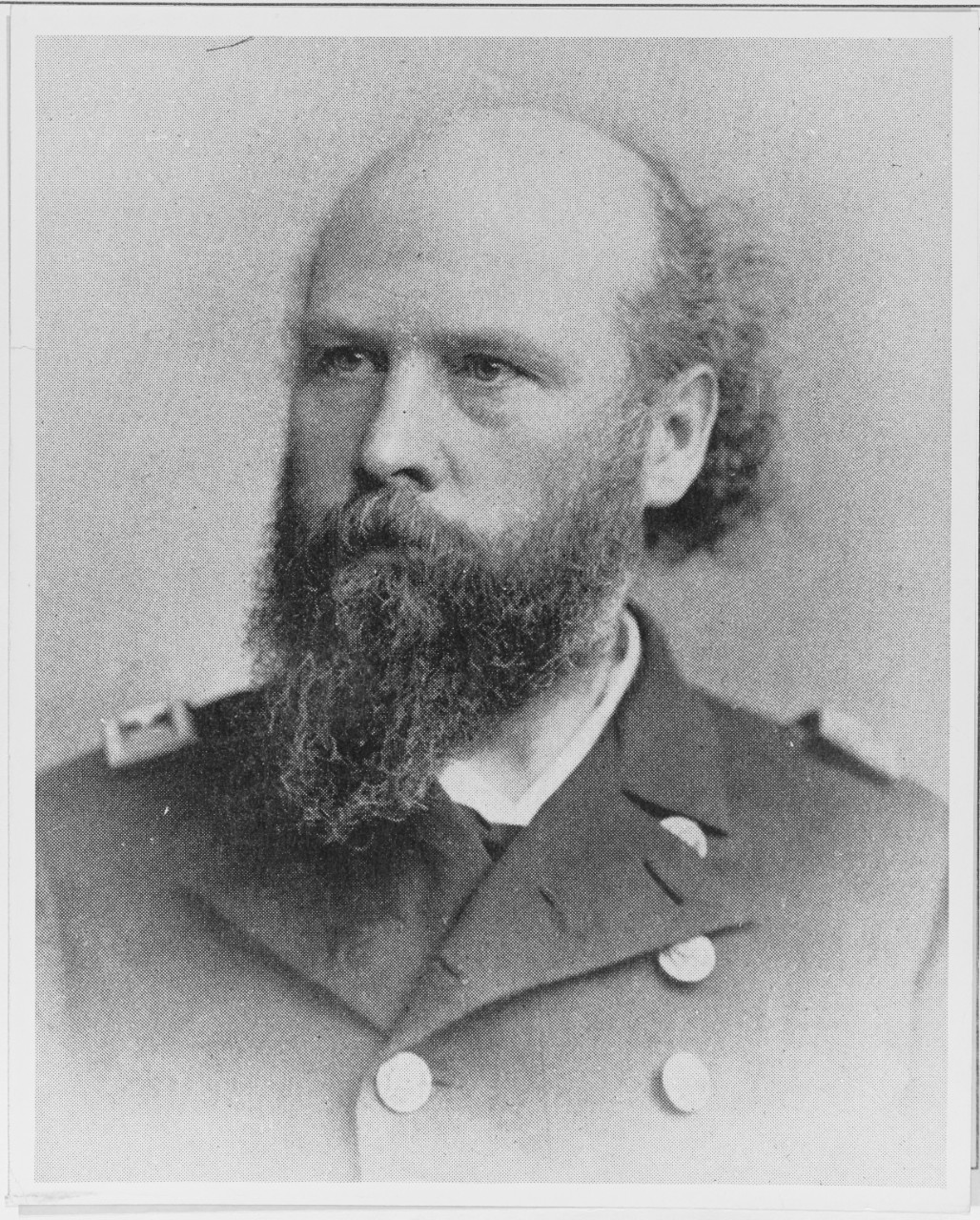
He spent his first year at sea on board iron-hulled side wheel steamer Michigan in the Great Lakes, and served in steam sloop Dacotah, primarily while she operated in the North Atlantic Blockading Squadron, from mid–1862 until late in 1864, when he joined screw sloop-of-war Wachusett. That ship hunted for Confederate raiders and on 4 October 1864, Comdr. Napoleon Collins of Wachusett sighted one such raider, Florida, Lt. Charles M. Morris, CSN, in command, entering Bahia harbor, Brazil. Collins dared Morris to come out and fight, but the Confederate captain prudently declined. Melville donned civilian garb and boldly attempted to board the raider in broad daylight, knowing his fate in the event that he was taken, but he eluded capture. Collins remained determined not to allow Florida to slip away, and in the early morning darkness of the 7th, Wachusett got underway, steamed past a Brazilian gunboat anchored between the Union ship and her prey, and rammed the raider on her starboard quarter. After a brief exchange of cannon fire, the Confederates surrendered the ship. The commotion alerted a coastal battery at Fort Barra and the Brazilians opened fire on Wachusett as she towed her prize to sea. The two vessels escaped unscathed, steamed north, and reached Hampton Roads, Va., on 11 November. “The joyful news,” The New York Times observed on the 11th, “spread over the city like wildfire, and was the universal subject of discussion and of mutual congratulation…” Collins was promptly court-martialed for the incident, but Secretary of the Navy Gideon Welles restored him to his command soon after.
The end of the American Civil War the following year found Melville in Hampton Roads. After the war, he served in several ships including experimental cruiser Chattanooga, and double-ended, side wheel steamer Tacony, and sailed on board the latter when she observed the French evacuate Mexico in 1867. He next (1869–1871) went to sea in steam sloop Lancaster, the flagship of the South Atlantic Squadron, where he was commended for exhibiting “an amount of mechanical ability, energy and engineering skill rarely found.” He subsequently served in the Asiatic Squadron’s flagship, screw frigate Tennessee.
Melville entered a new phase of his life when he took part in exploratory voyages. Late in 1870 the Navy selected screw tug Periwinkle for service with the Hall Scientific Expedition to the Arctic. The tug completed repairs at Washington Navy Yard and early in 1871 was renamed Polaris. She arrived at New York Navy Yard on 9 June 1871, to complete loading stores and provisions for the expedition. Under civilian explorer Charles F. Hall’s command, the expedition of 25 men sailed on board Polaris, Sidney O. Budington, Master, from the yard in July 1871. Aiming for the North Pole, she reached 82'1°11' N. Hall died on 8 November and Budington assumed command of the party, unsuccessfully resumed the attempt to reach the North Pole, and then brought the ship about. Ice caught Polaris on her homeward voyage through Smith Sound, between Greenland and Ellesmere Island, in October 1872, carried the vessel for some distance, and then ran the ship aground near Etah in northern Greenland and crushed her on the 24th. Fourteen of the men set out in a pair of boats, and a whaler rescued them and they returned home via Scotland, while the rest of the crew and their Inuit guides struggled to survive the harsh winter while encamped ashore. Melville volunteered for duty as chief engineer of screw steamer Tigress, a former sealer, as she set out to rescue the castaways. Tigress braved the bitter northern extremes and rescued the 19 survivors in Baffin Bay on 30 April 1873, a feat for which Melville was commended for his “great fertility of resource, combined with thorough, practical knowledge”.
He also volunteered to join the North Polar expedition, better known as the Jeannette expedition, an attempt to seek an ocean passage to the Atlantic by way of the Bering Strait to the North Pole. New York Herald publisher James G. Bennett presented steam bark Jeannette to the Navy, and, Lt. George W. DeLong in command, she put to sea from San Francisco, Calif., on 7 August 1879. DeLong left a photograph of himself “For my wife to look at when she is wondering where I am.” Melville sailed as the chief engineer with the other 27 Navy officers and men and three civilian volunteers. Jeannette crossed the Arctic Circle in September but became icebound, and pack ice entrapped the ship for nearly 21 months. The men persevered through the horrific circumstances and bravely recorded scientific observations that aided subsequent explorers, however, shifting ice floes in the Laptev Sea exerted such pressure on Jeannette’s specially reinforced hull that they crushed and sank the ship on 12 June 1881.
The crew set out on a torturous journey across the ice on foot, dragging three ship’s boats and plodding westward toward the Siberian shore. They attained the edge of the pack ice on 12 September 1881, and pushed off in their boats for the mainland. Lt. Charles W. Chipp and seven men took one of the craft but it broached and sank in a storm with all hands. The surviving two boats became separated and DeLong reached the eastern bank of the Lena River, a largely uninhabited wilderness area. The lieutenant and his men stoically attempted to reach civilization overland but weakened from their deprivations, and DeLong made camp and sent two men to search for help. Melville meanwhile led the third boat party and they reached comparative safety at the Lena Delta. DeLong’s men encountered a caravan but communication difficulties hindered their meeting, and they finally found Melville and his survivors. Although also suffering from the ravages of their trial, Melville and his men returned to the camp on 23 March 1882, only to make the macabre discovery of the frozen bodies of DeLong and his companions. They recovered the expedition’s records and eventually returned to the United States, where Congress, on 3 September 1890, awarded Melville the Congressional Gold Medal for his gallantry and resourcefulness, and the Navy advanced him 15 slots on the promotion list. He meanwhile wrote about the expedition in his book, In the Lena Delta, published in 1884.
The same year that he published his account, Melville served as the chief engineer of Scottish built steamer Thetis for the Greely Relief Expedition. The Lady Franklin Bay mission, an Arctic exploratory party led by 1st Lt. Adolphus W. Greely, USA, had set out on board ship Proteus for the North Pole in 1881, but supply vessels failed to reach the 25 men of the party and people feared for their fate. Thetis sailed in company with two other ships: steam-powered and barkentine-rigged and former sealer Bear, Lt. William H. Emory in command, and Alert, a British wooden screw sloop temporarily loaned to the U.S. Navy, Cmdr. George W. Coffin in command, as part of a relief squadron led by Cmdr. Winfield S. Schley from New York on 25 April 1884. Other ships took part in the voyage at times, and Bear and Thetis finally rescued Greely and the six other emaciated survivors at their camp on Cape Sabine on Grinnell Island on 22 June.
Melville followed these harrowing voyages by serving as an Inspector of Coal (1884–1886), and then performed his final sea duty in protected cruiser Atlanta. He became Chief of the Bureau of Steam Engineering on 9 August 1887. During Melville’s administration of over 16 years, he superintended the design of 120 ships, including the machinery for Columbia (Cruiser No. 12) and Minneapolis (Cruiser No. 13). In addition, he helped introduce innovations such as the water tube boiler, vertical engines, and the repair ship. The experienced officer was promoted to rear admiral on 3 March 1899, and on 6 December 1900 appointed Engineer in Chief of the Navy. He fought hard to get an appropriation of $400,000 for an experiment and testing laboratory to be located at Annapolis, Md. In 1903, he finally succeeded and created the Engineering Experiment Station. Prior to his retirement, Melville also headed a committee tasked with studying how to use fuel oil in Navy boilers instead of coal. Rear Adm. Melville retired on 10 January 1903. Melville was divorced from his first wife but married his second wife, Estella S. Polis of New York, on 18 October 1907. Melville died on 17 March 1912 at Philadelphia, Pa., and is interred at Laurel Hill Cemetery at Philadelphia.
I
(Destroyer Tender No. 2: displacement 7,150; length 417' 3"; beam 54' 5"; draft 20'; complement 397; speed 15 knots; armament 8 5-inch, 1 3-inch, 2 3‑pounders, 1 18-inch torpedo tube; class Dixie)
Melville (Destroyer Tender No. 2) was laid down on 11 November 1913 at Camden, N.J., by New York Shipbuilding Corp.; launched on 2 March 1915; and sponsored by Miss Helen W. Neel, the late Rear Adm. Melville’s granddaughter.
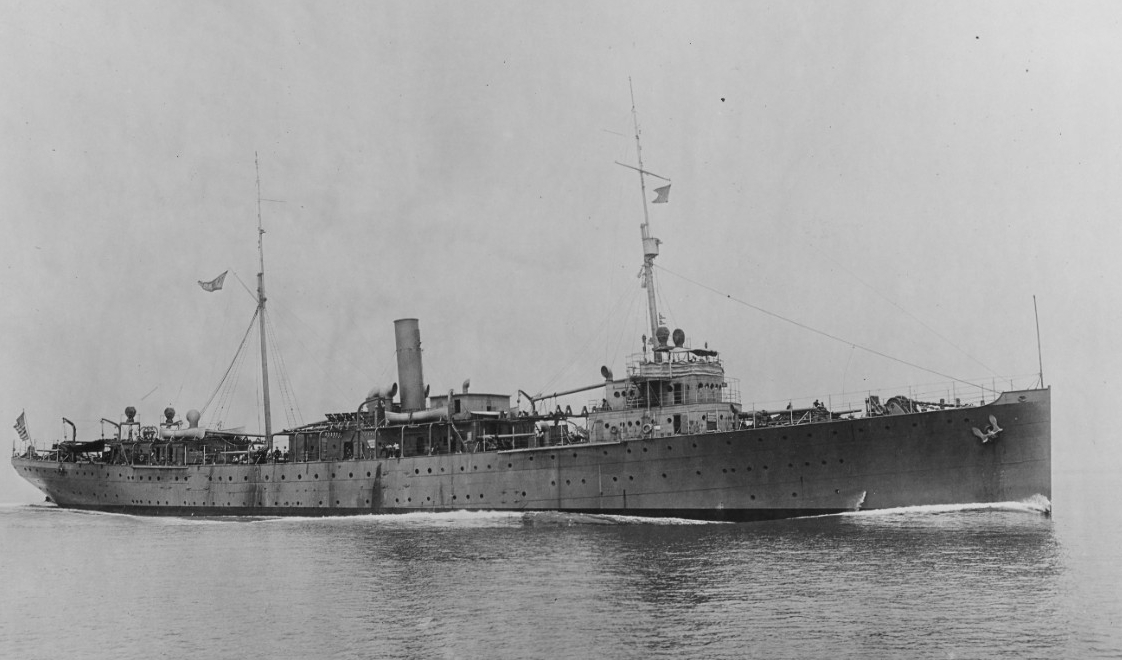
Commissioned on 3 December 1915, Melville, Cmdr. Henry B. Price in command, was assigned to the Atlantic Fleet, and reported to Newport, R.I. (4–7 January 1916). The ship cruised to various Caribbean ports and on 16 April took up her home at Boston [Mass.] Navy Yard. The stores that she loaded on board on 2 May provide a glimpse of one aspect of life in the Navy at that time that included: 864 tins of Velvet tobacco, 720 packages of Union Leader tobacco, 288 tins of Piper Heidsieck chewing tobacco, 400 pounds of Star chewing tobacco, 450 pounds of B&B Best Navy chewing tobacco, 288 clay pipes, 144 packages of pipe cleaners, and 5,000 books of Riz-la-X cigarette papers. Life in port, however, could hold its own perils and four days later a fire broke out on board Constitution, and Melville called away her fire party to assist the famed frigate’s crew in extinguishing the flames. That same day, 6 May, Melville entered a dry dock and had her bottom cleaned and painted.
On 6 April 1917, the ship lay moored while she serviced destroyers of the Seventh, Eighth, and Ninth Divisions at Base 2 at Yorktown, Va., when Radio Cornet 131106 from Rear Adm. Henry T. Mayo, Commander-in-Chief, Atlantic Fleet, momentously notified her of the U.S. entry into the World War. Cmdr. Price took stock of the ship’s readiness and in addition to her gunnery ammunition, reported that at that time she had 100 Mk. III Naval Defense Mines “loaded with TNT,” along with eight Mk. V, Mod. 4, three Mk. VII, Mod. 2, and nine Mk. VIII torpedoes, as well as six defective torpedoes that her crewman had “surveyed.”
Rear Adm. Albert Gleaves, Commander, Destroyer Force, Atlantic Fleet, radioed Price from his flagship Seattle (Armored Cruiser No. 11) on 28 April 1917, directing him to proceed from Hampton Roads for Boston Navy Yard in order to “fit out for distant service with all possible despatch”. The ship sailed to Boston (28–30 April), entered dry dock and had her bottom cleaned and painted (2–3 May), provisioned and fueled, and, mustering a ship’s company of 509 -- 27 officers and 482 enlisted men -- set out across the Atlantic for Queenstown [Cobh], Ireland, on 11 May. Price issued his aggressive Ship Order No. 7 to emphasize the severity of confronting German U-boats during the [First] Battle of the Atlantic:
“Every man on watch must be alert and vigilant, keeping a sharp lookout for a periscope in his own arc, every instant of the time he is on watch…”
“It is reported that German submarines are now operating in groups [a chilling reference to the possibility that a U-boat could act as a decoy to lure escorts from convoys to enable the other boats to attack]...”
“If a periscope is seen by any member of any gun’s crew, the gun captain will instantly order his sight set at the range he considers the periscope to be at and the pointers will instantly train on the periscope and fire, without waiting to make any report or receive any orders…”
“Everyone must understand that a gun shot is an urgent call to torpedo defense stations…”
Consequently, the ship sailed with 20 rounds of ready ammunition at each gun, all of which were loaded and ready for use, and watch sections that comprised: one officer and a signalman in the crow’s nest; a sailor in the bow; one man each at No. 3 and 4 guns; a crewman in the after searchlight platform; and one chief petty officer on the after end of the deck house. Melville rendezvoused with Davis (Destroyer No. 65) and Wainwright (Destroyer No. 62) on 21 May, and at 12:11 p.m. the following day Price’s aggressive orders seemingly bore fruit when one of Melville’s lookouts sighted what appeared to be a U-boat’s periscope pop up through the “long rolling sea.” The tender sounded torpedo defense stations, manned all guns, increased to full speed ahead, and fired 24 5-inch rounds from her No. 1 gun before the crew realized their error in attacking a drifting buoy with an upright staff. Melville moored to Buoy No. 6 at Queenstown at 9:33 a.m. the following day, and Price called on British Vice Adm. Sir Lewis Bayly, RN, Commander-in-Chief, Coast of Ireland.
The ship began carrying out repair and support operations and tending destroyers on 24 May 1917. On 20 June Cmdr. Joel R. P. Pringle relieved Cmdr. Price, who went on to command Dixie (Destroyer Tender No. 1) while she also tended destroyers at Queenstown. Pringle led a busy life because in addition to leading the ship he also was designated as an aide to Vice Adm. William S. Sims, Commander, U.S. Naval Forces Operating in European Waters, on 28 June, and on 24 July was also designated as a U.S. aide to Vice Adm. Bayly. Pringle nonetheless received promotion to captain on 31 August. On 10 September, Sims hoisted his flag on board Melville, and issued instructions that she was to fly the admiral’s flag even in his absence, so as to indicate that the tender served as the flagship at all times.
On 30 September 1917 Pringle proudly reported that Melville had processed job orders for 29 ships since her arrival, and observed that the destroyers that Melville tended operated “in excellent condition…thus showing the logistical value of this ship.” The commanding officer also noted, however, that the number of ships that operated from Queenstown “taxed to the limit” the supply “features” of the base. “This has been met by renting and establishing on shore storehouses and cold storage facilities in which to properly care for the supplies arriving by vessels from home bases.” The ship also handled the distribution of gas, oil, and fresh and distilled water to the other U.S. ships that operated from that port. In addition, she normally processed all men transferred between the various vessels and other deployments, and, per Pringle’s assessment, controlled the American stores houses ashore.
Fanning (Destroyer No. 37) depth charged and sank U-58, Kapitänleutnant Gustav Amberger in command, off the southern Irish coast near 51°37ˈN, 8°12ˈW, on 17 November 1917. The battle killed at least two of the submarine’s crewmen but Fanning brought Amberger and three officers, one warrant officer, and 33 enlisted German prisoners of war in to Queenstown in triumph. The Americans took the officers to Dixie and the rest to Melville. The ship’s company searched the prisoners, gave the Germans dry clothes, dried and returned their own uniforms, and placed the prisoners under guard in various parts of the ship, separated at all times. They were transferred to British sloop Snowdrop the following day.
Kapitänleutnant Hans Rose’s U-53 torpedoed and sank Jacob Jones (Destroyer No. 61) with the loss of 62 men southwest of Bishop Rock near 49°35ˈN, 6°50ˈW, on 6 December 1917. The Germans captured two severely wounded survivors, Sea2c Albert DeMello and SC2c John F. Murphy, and took them on board the submarine as prisoners. Three and a half hours after the sinking, British steamer Catalina recovered seven of Jacob Jones’ people. British sloop Camellia recovered the main group of 42 survivors on three boats at 8:30 a.m. the following day and returned them to Queenstown, where they were transferred to Melville on the 8th. Lt. Cmdr. David W. Bagley, the destroyer’s commanding officer, earlier took a motor dory toward the Scilly Islands to seek help and a British patrol boat picked that group up at 1:00 p.m. on 7 December. Some of the men from these rescues were transferred to Burrows (Destroyer No. 29) and Sterett (Destroyer No. 27), and the surviving crewmen were gratefully reunited after their harrowing ordeal.
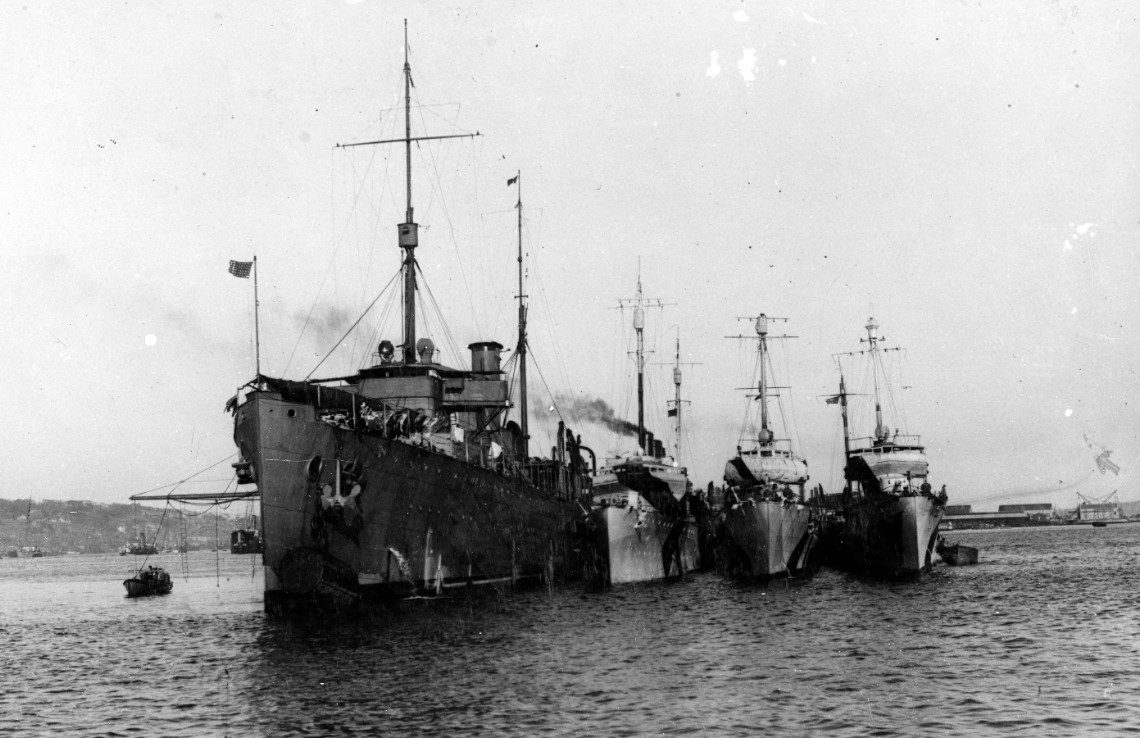
The ship’s myriad responsibilities gradually lessoned following the Armistice. During the forenoon watch on 4 January 1919, Sims boarded the ship and her crew mustered and marched aft, and the admiral delivered his farewell speech. Cmdr. John S. Arwine relieved Pringle, who moved to Corsair (S. P. 159), a former John P. Morgan Sr., yacht turned patrol boat that also served at times as Sims’ flagship. Melville stood out of Queenstown at 4:12 p.m. later that day and on the 6th reached Southampton, England, where a large group of U.S. officers from the Naval Base at Cardiff, Wales, and Naval Headquarters in London embarked for transportation to the U.S. She set out for New York the following day, on 23 January reached Bermuda and took on fuel and oil, and received two officers and 26 men from Naval Port Office, Bermuda, for transportation home, and arrived at New York on 26 January. Four days later, Rear Adm. Charles P. Plunkett, Commander, Destroyer Flotillas, Atlantic Fleet, broke his flag in Melville. The ship granted liberty and leave for the crew after their arduous duty abroad, and in addition, carried out many transfers and discharges — 331 of the 395 men on board departed on ten days leave on the 29th.
The tender took on stores at Naval Supply Base, Brooklyn, N.Y., (17–27 February 1919), and then stood down the channel and loaded exercise torpedo heads from a lighter at Naval Torpedo Station Newport, after which she turned southward for warmer Caribbean waters (1 March–15 April). Melville stopped at Hampton Roads while en route (2–3 March), and briefly tended destroyers at Guantánamo Bay, Cuba (7–17 March). The ship supported fleet exercises off San Juan, P.R., in which destroyers and submarines practiced attacking battleships, along with other tactical maneuvers. Melville anchored at San Juan (21–27 March), and then Plunkett broke his flag in Robinson (Destroyer No. 88) for the exercises.
Melville then returned to Guantánamo Bay, steamed in formation with destroyers to the Gulf of Guacanayabo (31 March–1 April 1919), returned with destroyers of Divisions 5 and 12 to Guantánamo Bay on the 4th, and then came about for New York (9–14 April). Plunkett shifted his flag to Rochester (Armored Cruiser No. 2) and Melville was taken under tow for repairs at New York Navy Yard (21–28 April). Following the yard work she was again taken under tow and moored to Standard Oil Dock at Bayonne, N.J., where she took on fuel, and left the same day for Tompkinsville on Staten Island, N.Y.
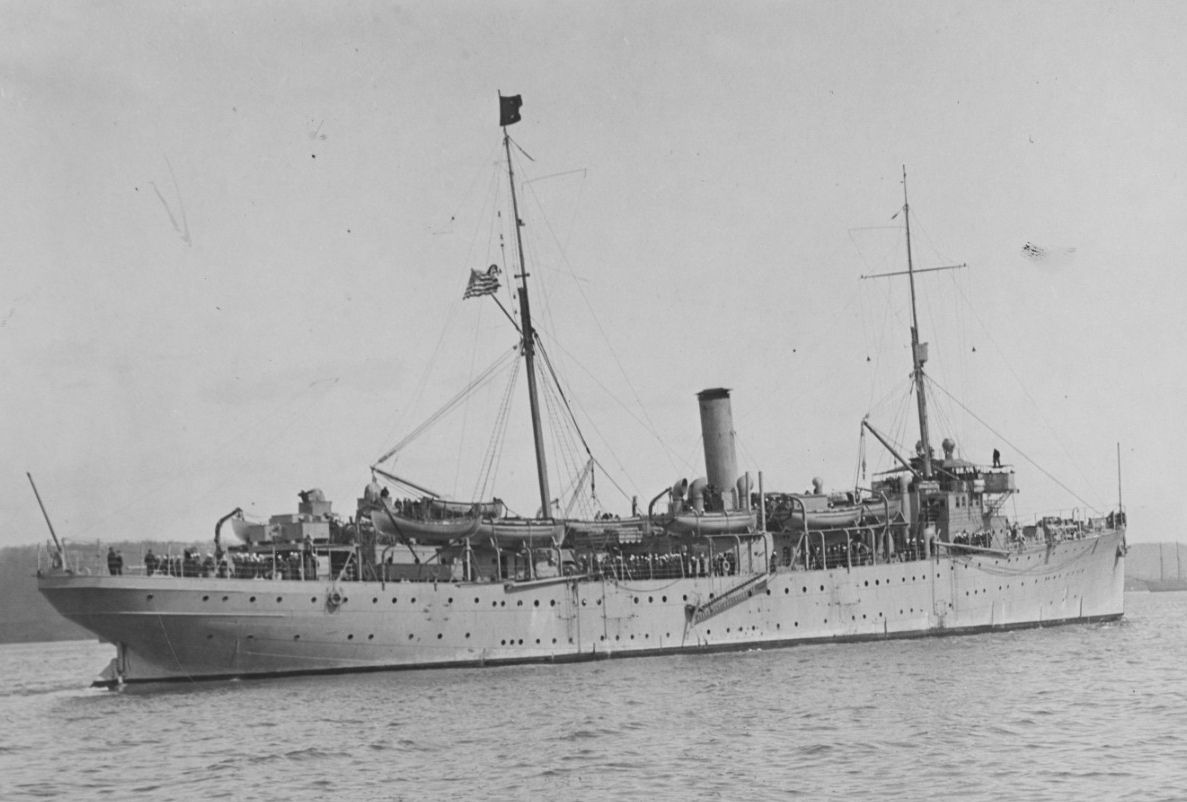
Melville anchored at Tompkinsville and took on supplies and more fuel to take part in the Navy’s attempt to be the first to fly planes across the Atlantic. Six journalists joined the ship to record the historic event. Jack R. Veiock, representing the International News Service, reported on board by authority of the Bureau of Navigation, and Stanley W. Premosyl of the Associated Press also did so by authority of Secretary of the Navy Josephus Daniels. Karl W. Fasold of the Pathé News Company, William R. Hargrave of the United Press, R. Kluver of the International Film Service, and A. L. Wetzel also embarked for the voyage. Melville eased out to sea on 30 April 1919, to join dozens of vessels, including battleships and destroyers, that deployed at intervals of about 75 miles along the aerial route to take meteorological observations, report weather conditions, light searchlights at night to guide the planes, and to communicate with the aircraft by radio or light during interference by haze, fog, or rain. Each ship was to show a number in such a way as to be plainly visible from aloft at a height of 2,000 feet or less. For the daylight zones, their crewmen were to paint black numbers eight feet high on a white background stretched across the forecastle deck on awning ridge ropes or painted onto the forecastle deck well forward of the bridge. They were to display eight foot high illuminated numbers in the night zone during darkness, to be placed in such a way that seaplane crews could read them as they approached from astern. Melville reached Ponta Delgada in the Azores on 8 May.
Planners prepared four Naval Aircraft Factory and Curtiss NC flying boats of Seaplane Division 1, Cmdr. John H. Towers in command, to assay the perilous crossing, but sailors removed the wings from NC-2 (BuNo. A-2292) and installed them onto NC-1 (BuNo. A-2291) to repair storm damage to the plane. Consequently, Towers commanded the three remaining flying boats: NC-1, manned by Lt. Cmdr. Patrick N. L. Bellinger, Lt. Cmdr. Marc A. Mitscher, Lt. Louis T. Barin, USNRF, Lt. Harry Sadenwater, USNRF, MMC C.T. Kesler, and Machinist Rasmus Christensen; NC-3 (BuNo. A-2293), Towers, Cmdr. Holden C. Richardson, CC, Lt. Robert A. Lavender, Lt. David H. McCulloch, USNRF, and Boatswain Lloyd R. Moore; and NC-4 (BuNo. A-2294), Lt. Cmdr. Albert C. Read, Lt. James L. Breese, Lt. Elmer F. Stone, USCG, Lt. (j.g.) Walter K. Hinton, Ens. Herbert C. Rodd, and MMC Eugene S. Rhoads. Chief Rhoads replaced MMC Edward H. Howard just before the flight when NC-4’s spinning propeller sliced off the engineer’s left hand, although Howard later resolutely returned to duty.
Towers led NC-1, NC-3, and NC-4 from Naval Air Station (NAS) Rockaway, N.Y., to Halifax, Nova Scotia, on the first leg of the transatlantic flight during the forenoon watch on 8 May 1919. The division hoped to fly 1,150 miles to Trepassey Bay in Newfoundland in two stages, rather than ship the planes in order to gain experience before attempting the crossing. NC-1 and NC-3 arrived at Halifax before dark but NC-4 developed trouble in her oil feed off the Massachusetts coast that compelled a descent to the water and taxi overnight to NAS Chatham, Mass. Following two days at Halifax, NC-1 and NC-3 continued on to Trepassey Bay. NC-4 completed repairs at Chatham and made for Halifax, from whence she left the following day for Trepassey Bay.
In addition to the flying boats’ mechanical issues, meanwhile, reports of storms roaring across the Atlantic weighed on Towers and persuaded him to delay the flight. Maumee (Fuel Ship No. 14) played a key role in his decision to continue, however, in that the ships deployed along the route to the Azores burned through their fuel at a disconcerting rate, and if Towers had waited much longer, they would have needed additional refueling but he determinedly resumed the attempt, in part banking on Maumee’s availability. A few minutes after 6:00 p.m. on 16 May 1919, the three big flying boats took off from Trepassey Bay for the aerial voyage to the Azores, with NC-3 in the van. Radioman Rodd intercepted a radio message from steamship George Washington 1,325 miles distant, at 1:22 a.m. on 17 May. At another point a radio station at Bar Harbor, Maine, intercepted a message from one of the planes from about 1,400 miles away. During the morning watch dense fog blinded the flying boats and separated the division but NC-4 resolutely ascended above the fog. Following more than 15 hours in the air NC-4 descended to Horta in the Azores at 1:23 p.m. on 17 May.
The other boats lost their bearings in the fog, however, and landed at sea to determine their positions, sustaining damage that rendered them unable to resume the flight. Bellinger descended to the water at a point 45 miles on the other side of Flores but heavy seas disabled the plane. NC-1, after five hours in the water, was taken in tow by the Greek steamer Ionia but the lines parted. Gridley (Destroyer No. 92) then attempted to take NC-1 in tow but the sea pushed the aircraft adrift and NC-1 broke up and sank. The crew clambered on board Ionia and reached Horta at 12:30 p.m. the following day. Towers landed at a point around 35 miles from the island of Fayal. The flying boat encountered heavy seas that rose overnight until a gale the next morning carried away NC-3’s port pontoon. The men weighed down the starboard wing tip with their bodies to keep the port wing clear of the water. The plane drifted backward toward the Azores and arrived at Ponta Delgada at 4:50 p.m. on 19 May.
Harsh weather delayed NC-4 until she flew to Ponta Delgada the following day, where the craft remained for nearly a week, undergoing repairs and awaiting more favorable weather. Early on the morning of 26 May 1919, Read and NC-4 departed for the 891-mile flight to Lisbon, Portugal, encountering two heavy rain squalls en route but completing the first crossing of the Atlantic Ocean by air when the plane landed at 8:01 p.m. on 27 May to the accompaniment of cheering thousands, ringing church bells, ships blowing their whistles. NC-4 became the only one of the three NC flying boats to reach the Azores by air. Read lifted off on the last legs of the flight on 31 May. The flying boat dodged several small squalls and encountered rain but developed a leak in the port engine that forced the plane to put down for repairs in the Mondego River near Figueira da Foz [Figuera], Portugal. NC-4 got underway with the high tide and arrived overnight at Ferrol, Spain. NC-4 flew across the Bay of Biscay, circled over Brest, and despite thick weather arrived at Plymouth, England, at 1:26 p.m. on 31 May. Planners symbolically chose Plymouth as the terminal point of the flight because of the Pilgrims’ departure for America from that port.
During the following week, men of the flight met world leaders including the Prince of Wales Edward VIII and members of the British cabinet in London, and President Woodrow Wilson and the British, French, and Italian Prime Ministers David Lloyd George, Georges B. Clemenceau, and Vittorio E. Orlando, respectively, at the peace conference at Versailles, France. NC-3 was hauled ashore, disassembled, and placed on Melville for shipment to the U.S. The ship turned her prow westward from Punta Delgada with her unique cargo and returned to New York (2–10 June), where the plane was unloaded to a lighter and Melville moored at Fleet Supply Base Brooklyn. The tender accomplished further voyage repairs at Boston Navy Yard and returned to Hampton Roads (5–13 July).
Melville was meanwhile transferred to the Pacific Fleet’s Fourth Destroyer Squadron. She stood out of Hampton Roads on 19 July 1919 for the west coast via the Panama Canal. At 4:46 p.m. on 24 July, a boiler tube blew out in Boiler No. 2 and fatally scalded five men: Floyd Grisham of Rogersville, Mo.; Douglas M. Hambliss of Jasper, Texas; Joseph Hart of El Paso, Texas; John J. O’Grady of Brooklyn; and Claude Turner of Knoxville, Tenn. The explosion also burned a sixth man about the neck and ears, though he survived. Melville hove to, hoisted the international signal of distress, and sent out SOS calls. Orion (Collier No. 11) answered Melville and took the ship under tow to Colón at the Panama Canal Zone.
Two days later Melville passed through the canal in company with multiple ships including Arkansas (Battleship No. 33), New Mexico (Battleship No. 40), New York (Battleship No. 34), Texas (Battleship No. 35), and 20 destroyers. “The flagship [New Mexico],” Adm. Hugh Rodman, Commander-in-Chief, Pacific Fleet, observed, “was lifted out of the three locks of Gatun dam in one hour and seventeen minutes. Now let us go tarpon fishing near the dam — getting dreadnaughts through the canal is too easy.”
Melville remained at Balboa until 26 October 1919, then set course for San Diego, where she arrived on 31 October. Sailing from San Diego for Pearl Harbor, T.H., on 25 March 1920, Melville remained there until 21 April, when she returned to her home port. Late in October she steamed for Mare Island Navy Yard, Vallejo, Calif., where she underwent an extensive overhaul. On 7 January 1921, the ship, along with most of the Pacific Fleet, stood out for Valparaiso, Chile, via Balboa. Melville crossed the equator on 23 January, and from 7:30–10:45 a.m. the shellbacks humorously initiated the pollywogs into the mysteries of King Neptune’s realm. Melville continued southward and moored at Valparaiso (2–6 February), where, on the 3rd, she broke her liberty party’s sojourn ashore and joined the other ships of the Pacific Fleet as they passed in review before President Arturo Alessandri of Chile and his entourage. The ship returned to San Diego on 7 March and in June completed an interim dry docking at Mare Island.
On the second day of January 1924, Melville got underway for Culebra Island, P.R., where she spent several weeks before steaming for Savannah, Ga., and arrived there on 2 March. Nine days later, the ship sailed for Key West, Fla., arriving on 14 March. After calling at Culebra and Colón on her return voyage, Melville passed through the Panama Canal and on 22 April returned to her home port of San Diego. The tender accomplished an overhaul at Mare Island (1 May–12 July), anchored at Port Angeles, Wash. (17 July–September), lay at anchor in San Francisco Bay for some three weeks, and returned to San Diego on 1 October. Melville completed an overhaul at Mare Island (21 February–12 March 1925) and returned to San Diego. On 3 April she rounded Point Loma and turned northward, lay at San Francisco for ten days, and then shoved off for Pearl Harbor. The ship moored there on 28 April and ten days later went on to anchor at Lāhainā Roads off Maui until 28 May, when she returned to Pearl Harbor.
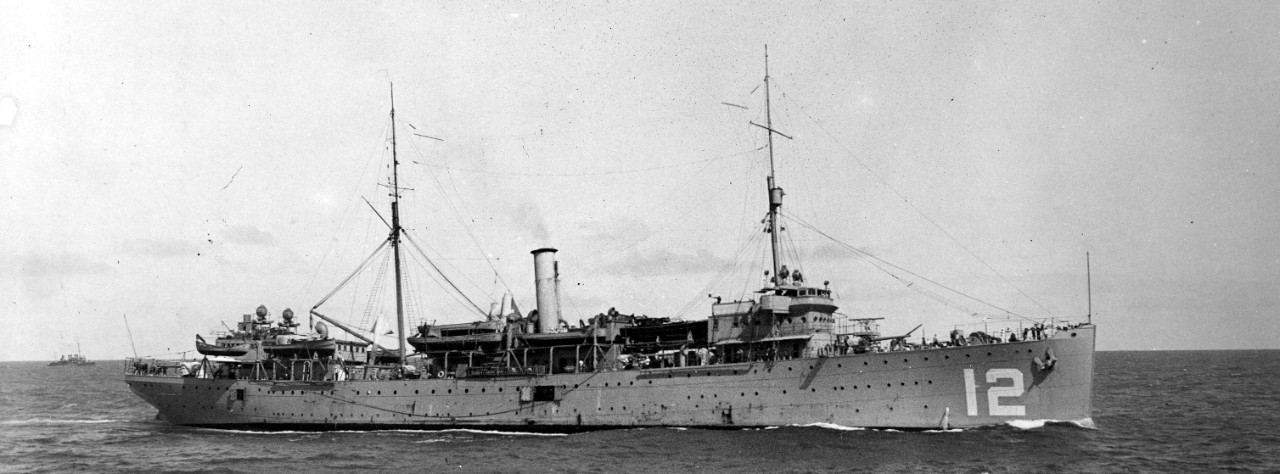
During the months of February and March 1926, Melville went through a period of extensive overhaul at Mare Island Navy Yard. The destroyer tender arrived at San Diego on 5 April, and that summer steamed for Port Angeles, where the ship remained until her return to San Diego on 1 September. Melville continued with her familiar schedule and accomplished an overhaul at Mare Island early in the New Year (15 January–7 February 1927).
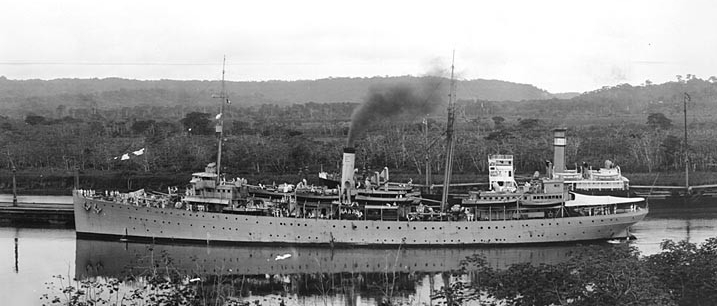
Melville then supported the Special Service Squadron, which “showed the flag” and protected Americans across the Caribbean and Central America, and, on occasion, South America. Fighting between rival factions flared in a number of countries in the area throughout the 1920s and 1930s, and their struggling governments often invited American assistance. Ships of the squadron supported marines and soldiers deployed ashore maintaining order in multiple crises including El Salvador, Guatemala, Haiti, Honduras, Nicaragua, and Santo Domingo [the Dominican Republic]. In addition, they responded to disasters and provided humanitarian assistance, such as when aircraft carrier Lexington (CV-2) sailed from Guantánamo Bay to support marines and other ships, including hospital ship Relief (AH-1), that helped victims of an earthquake that demolished much of Managua, Nicaragua, on 31 March 1931. Melville called at San Pedro, Calif., from which port she steamed to Corinto, Nicaragua (19–26 February 1927), and two days afterward sailed for Balboa. After visiting Caribbean ports, Hampton Roads, and New York, she arrived at Newport on 19 May. She stood out to sea nine days later and returned to her home port on 27 June.
The ship headed for the Pacific Northwest again that summer when she steamed to Seattle, Wash. (11 July–22 September 1927), and stopped off for an interim drydocking at Mare Island on her return trip. Melville fired short range battle practice on 23 September, and the following year (22–24 March 1928) engaged in fleet tactics off Coronado Islands, Calif. The ship sailed up the west coast again that year, set out from San Diego to train on 9 April, reached San Francisco on the 28th, completed work in dry dock at Mare Island (12 June–11 July), visited Port Angeles, and on 17 August came about for home. During the months of June, July, and August of 1929, the ship visited San Francisco, Mare Island, Port Angeles, and Puget Sound Navy Yard at Bremerton, Wash., and 28 August found her again moored to a buoy at San Diego. Melville carried out an overhaul in dry dock at Mare Island (13 November–17 December 1930) and rounded out the year at San Diego. Melville got underway for Balboa early in the New Year (5–22 February 1931), and the following month took part in tactical exercises in the vicinity of the Perlas Islands. Except for a short period of dry docking at Mare Island in January, the ship was at home in San Diego during the entire year of 1933. During the months of January and February 1934, Melville was back at Mare Island for an overhaul.
The annual fleet problems concentrated the Navy’s power to conduct maneuvers on the largest scale and under the most realistic conditions attainable. Three separate exercises designed to enhance realism comprised Fleet Problem XV in the Caribbean and in Panamanian waters (19 April–12 May 1934). Melville set out for the problem on 9 April, passed through the Panama Canal and supported ships in the exercises. Aircraft sank Saratoga (CV-3) and put Lexington out of action. On 6 May six Grumman FF-1s from Lexington “shot down” rigid airship Macon (ZRS-5) — although she transmitted a sighting report of the carrier. Observers noted the liability of airships in fleet operations and counterbalanced their great cost, slow speed, and vulnerability unfavorably with their value as scouts. The increase of the fleet problems in complexity and duration led umpires to initiate periodic recesses to rest crews. The lessons learned included the advancement of the idea of small carriers to solve recovery concerns, the inefficiency of battleship and cruiser plane handling, the necessity for carrier planes capable of carrying 500 and 1,000 pound bombs, and the requirement of improved aircraft tenders to replace the slow and poorly equipped ships in service. Following the exercises Melville turned to northerly courses and took part in a fleet review off New York and moored at Hoboken, N.J., on 31 May, and on 18 June departed for Newport, where she lay at anchor until 6 September. The ship sailed for home via Hampton Roads and Guantánamo Bay, and returned to San Diego on 9 November. In early December 1934, the ship completed voyage repairs in dry dock at Mare Island.
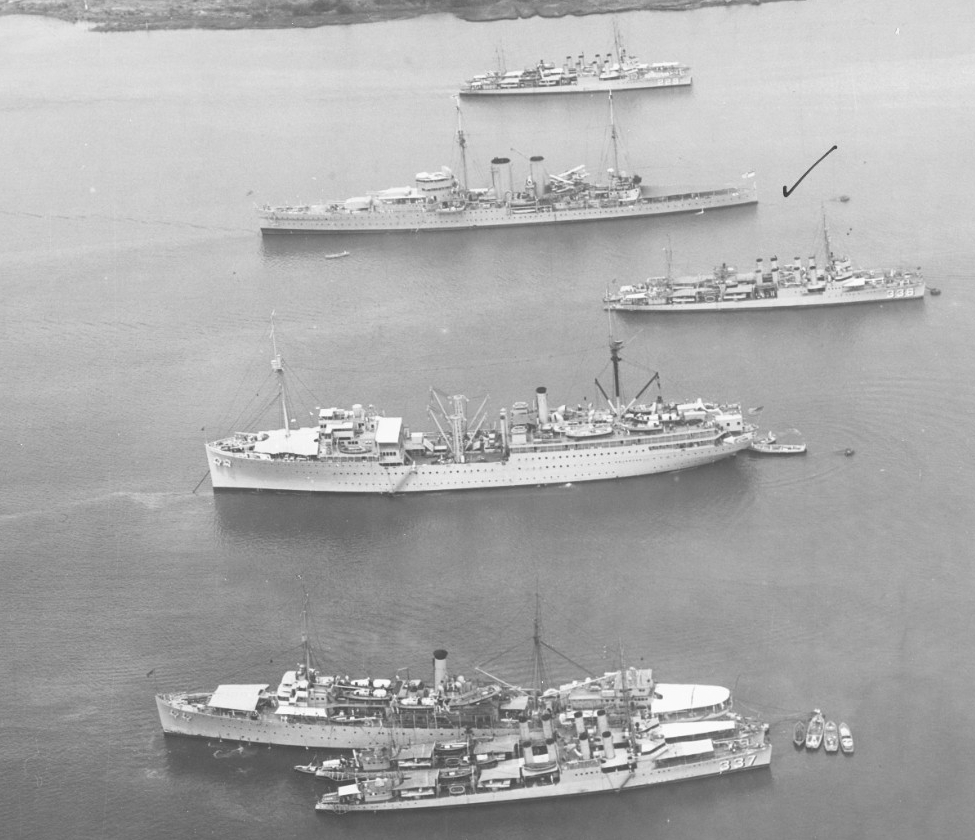
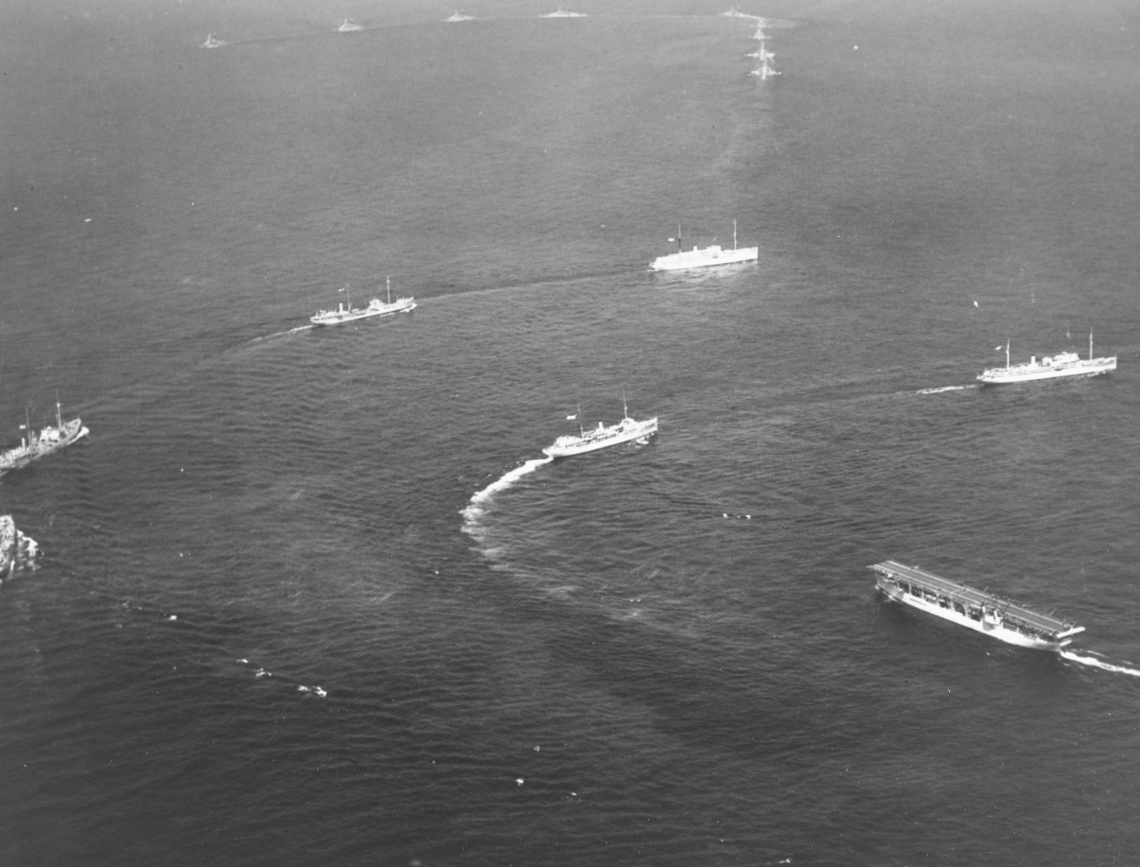
The deleterious effects of the Great Depression impacted the readiness and upkeep of ships like Melville, a troubling issue that Secretary of the Navy Claude A. Swanson noted in his Annual Report on 30 June 1934: “While the material condition of the fleet has been maintained to a reasonably satisfactory degree during the year, this is due only to the increase of self-maintenance by the forces afloat. The restricted funds available for repairs and alterations have been expended almost entirely for the former, alterations being authorized only in most urgent cases. Many of the alterations remaining outstanding due to lack of funds are of the highest importance. Their completion would improve the economy, reliability, and military efficiency of the ships.”
Melville stood out for Pearl Harbor on 27 April 1935 and arrived on 12 May. The ship remained moored there until 31 May when she sailed for San Diego, completed an overhaul at Mare Island (1 July–3 September 1935), and then rendered services to destroyers. Having passed two decades of active service, the ship again completed an overhaul in dry dock at Mare Island (31 March–8 April 1936). Melville tended destroyers at Balboa (27 April–8 May), and then (26 May–6 June) went back to sea and returned to San Diego. The ship set out for Mare Island just before Christmas on 18 December, completed an overhaul in dry dock at the navy yard there (20 December 1936–9 February 1937), and returned to the increasingly familiar maritime city of San Diego on the 10th.
During the nine phases of Fleet Problem XVIII (4–9 May 1937), an enemy fleet attempted to establish an advance base in the Hawaiian Islands. The problem included a simulated attack on facilities on Oahu. Lexington of the Northern Force launched a strike against Wheeler Field (USAAC). Saratoga of the Oahu Bombardment Force sent her planes against coastal guns between Pearl Harbor and Diamond Head. Ranger (CV-4) of the Hilo Force sent her aircraft against the Pearl Harbor Navy Yard. In addition, Black carriers Lexington and Saratoga and White Ranger launched strikes against each other. Melville sailed in company with other ships of the fleet’s train for Pearl Harbor (16–25 April), set out for the problem on the 29th, operated off Midway Island on 4 May, and following the problem came about for San Diego (20–28 May). Melville turned her prow northward on 23 June and celebrated Independence Day at San Francisco (25 June–6 July), continued on to Seattle and Port Angeles (9–26 and 26–31 July 1937, respectively), and returned to San Francisco.
The seasoned ship trained and supported the fleet in southern Californian waters into the New Year, completed an overhaul at Mare Island, and then (30 March–21 April 1938) took part in Fleet Problem XIX. Severe weather hampered the 12 phases of the problem in the Northern Pacific between Alaska and the Hawaiian Islands (16 March–27 April). The exercise included air attacks against enemy shores by several carriers approaching at high speed from separate directions, and the maturation of the idea of fast carrier task forces. During Phase 1, 36 patrol bombers flew more than 1,000 miles from San Diego and bombed several ships including Lexington, destroying the planes spotted on her flight deck and damaging the deck beyond repair. In Phase 5, the Blue fleet attacked the Hawaiian Islands, which were defended by the Red fleet and mined approaches. An epidemic of tonsillitis on board Lexington deleted her from flight operations and Saratoga fulfilled the role of Lexington. Saratoga attacked at 0450 on 29 March from a position about 100 miles to the northward of Oahu, having masked her approach by sailing on the easterly side of a weather front. Saratoga’s reconnaissance aircraft spotted light cruiser Richmond (CL-9) north of Lāhainā Roads, and her attack group bombed the Fleet Air Base, Wailupe Radio Station, and Hickam and Wheeler Fields, returning on board by 0835. The carrier launched a second strike that morning against the ships and facilities at Lāhainā, but the defenders retaliated and lightly damaged Saratoga.
Melville slid through the Panama Canal into the Caribbean (9 January–2 May 1939) for Fleet Problem XX, which ranged across the Caribbean and the northeast coast of South America, and included Enterprise (CV-6) and Yorktown (CV-5) for the first time (20–27 February). President Roosevelt observed the problem initially from on board heavy cruiser Houston (CA-30), transferred to Pennsylvania (BB-38), and then returned to Houston to watch the final exercises, and the chief executive’s presence led to the maneuvers becoming unusually publicized. The problem included the employment of planes and carriers in connection with escort of a convoy, the development of coordinating antisubmarine measures between aircraft and destroyers, and the trial of various evasive tactics against attacking planes and submarines. Controversy arose over the efficacy of patrol plane attacks on carriers and other ships, the principal that patrol aircraft operate as scouts required emphasis. Evaluators also recommended the necessity of fast battleships to supplement cruisers in carrier task forces. Melville also visited Gonaïves Bay, Haiti, Guantánamo Bay, and Charleston, S.C., before coming about and returning to the west coast via the Panama Canal.
Melville missed Fleet Problem XX (April–May 1940) but stood out of San Diego for Hawaiian waters (9 June–24 August), where she supported the fleet in a series of training exercises and for maintenance and upkeep. The ship returned to San Diego on 1 September, but with the threat of American involvement in World War II growing stronger, Melville steamed for the Caribbean on 12 September.
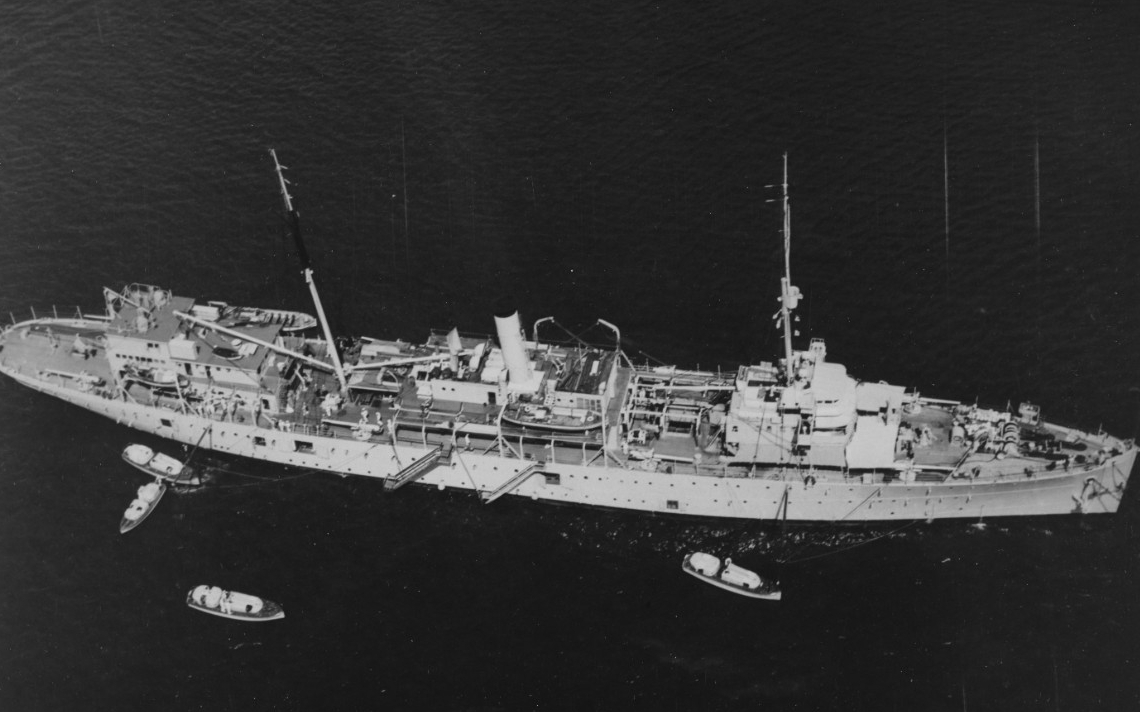
The warship stopped at Balboa and Cristóbal in the Panama Canal Zone, San Juan, Guantánamo Bay (7 October–17 November), St. Thomas in the Virgin Islands, Culebra, P.R., and reached Naval Operating Base (NOB) Norfolk, Va., on 9 December. She completed voyage repairs and an overhaul at Norfolk Navy Yard, served with the Patrol Force, U.S. Fleet, and on 1 February 1941 was transferred back to the Atlantic Fleet. Following intensive training at Guantánamo Bay and Culebra, as well as three weeks of supply duties at Casco Bay, Maine, Melville continued on to Bermuda on 16 September in order to service neutrality patrol ships, until returning to Norfolk on 28 November.

Melville got underway on 12 January 1942 for Europe, plowed through U-boat-infested waters and reached Londonderry, Northern Ireland, on 31 January, and began tending escort ships of Allied convoys crossing the Atlantic. During the next two years she was also based at Newport and Casco Bay while continuing support services. The ship in the meantime in April 1942 set out across the Atlantic for Hvalfjörđur, a fjord in the west of Iceland. The Allies had occupied the country (1940–1941), and in particular, U.S. forces built and utilized a fuel depot at the fjord that initially serviced British troops garrisoning the island, and cared for the trans-shipment of fuel from U.S. bottoms to other Allied vessels. The Americans continued to expand their limited facilities while Melville operated in the area, and severe wind and snow storms that swept across the area caused the ship additional problems.
Germans U-boats attacked ships in Brazilian waters during the Second Battle of the Atlantic, and mariners referred to the area off the Amazon River as “Torpedo Junction.” As a result the U.S. deployed warships to those waters and they required a tender, so Melville left nearly 200 of her men in Iceland to help the Allies expand the station at Hvalfjörđur, and returned across the Atlantic and completed an availability at New York. The ship received new crewmen and then turned her prow southward for warmer climes and anchored at Recife, Brazil. During her nine months (5 February–23 September 1943) spent in those balmy waters she serviced U.S., British, and Brazilian cruisers, destroyers, corvettes, gunboats, submarine chasers, and auxiliaries. Cmdr. Rony Snyder received the Legion of Merit for his “exceptionally meritorious conduct” while commanding the ship during these operations in the South Atlantic. The 58-year-old Snyder, who hailed from Winchester, Mass., worked with “tireless energy and superb skill” despite the “limited” repair facilities and logistics support, and “responded to every demand with unvarying cooperation, although many requests were above and beyond the normal capacity” of the ship.
In early March 1944, Melville sailed for Rosneath, Scotland, and after re-arming tank landing ships (LSTs) sailed to southern England. Her technicians were called upon to repair myriad appliances in addition to her regular duties repairing reduction gears and the placement of boat davits designed to support the six-ton LCVP Higgins invasion boats. Special gear was installed on some of the LSTs to facilitate the removal of battle casualties and to convert them in to floating hospitals for the emergency cases being returned to field hospitals in England.
“We’re an old ship using new methods,” Cmdr. Francis Taylor, the commanding officer, declared to Navy journalists. “That’s the secret of this work. The Navy has provided the MELVILLE with the new machinery and modern devices at every innovation of ship equipment. Our men are experts. When a job comes alongside they just do it, and do it right, because they know how and because they like it.” Despite Taylor’s cheerful assessment, the aging ship also carried out the grim task of supporting damaged Allied ships, some of which limped alongside barely seaworthy from battling shot and shell or the elements.
“One ship took a near miss by a bomb,” Lt. Cmdr. Glen H. Thompson, USNR, of Burlington, Iowa, reflected. The ex-railroad man directed repairs from the ship, and recalled that the bomb cracked the vessel’s “steady rest bearing. Usually it takes a Navy yard to install a new one. Our patternmakers took the measurements and worked out a new pattern. We were having trouble with our compressors, however, so the molders were stuck until they rigged a line with our torpedo air compressors three decks below the foundry. Chief Helva [Chief Machinist Steven Helva of Treichlers, Pa.], and his molders worked 52 hours pouring 650 pounds of metal for the job…It was so heavy the machine shop had to jack it up to work on it, but it went aboard that ship and she’s back in service now.”
German bombers attacked Weymouth Roads on 28 May and hit McCook (DD-496), damaging her steam, water, and air lines, radar, sound equipment, rangefinder, and main battery director, disabling five guns, and causing the destroyer to lose steering control from the bridge. The ship escaped without casualties but the damage threatened to keep her out of the upcoming invasion for which she had been training. Melville’s craftsmen worked around the clock and cast new fittings and machined parts, and quickly had the destroyer back in fighting trim in time for D-Day, the Allied landings in German-occupied Normandy, France.
“Navigational damage from channel storms and beaching damage,” Lt. Edward H. Donnelly, USNR, of Slater, Mo., a repair officer, explained, “were enough in themselves to keep the MELVILLE shops working at full speed during most of this time.” Melville’s divers replaced 73 propellers and repaired the bottoms of many vessels whose propeller shafts were thrown out alignment when the ships hit the beach. Her men also repaired a myriad of appliances including electric hair clippers, potato peelers, armatures for dough mixers, and gears and parts for washing machines.
“We act as a station ship, among other things,” Lt. Cmdr. Donald W. Fairservis, USNR, of Bridgehampton, N.Y., elaborated. “Our boatmen take a tour of the harbor every day getting buoy positions of ships and a horde of other information. Young skippers come to us with their problems. We cut hair, fix teeth [the ship provided dental care to more than 3,000 LST crewmen], rate men, provide uniforms and anything else they want.”
“A good name for the ship,” he added pridefully, “would be Mother MELVILLE”.
Tragedy marred Allied preparations to invade Normandy, however, on 28 April 1944. German motor torpedo boats S-100, S-130, S-136, S-138, S-140, S-142, S-143, S-145, and S-150 of the 5th and 9th Motor Torpedo Boat flotillas attacked Convoy T-4, consisting of eight U.S. tank landing ships carrying soldiers of the Army’s 1st Engineer Special Brigade as the LSTs entered Lyme Bay during Exercise Tiger, and torpedoed and sank LST-507 and LST-531 off Portland Bill near 50°28'N, 02°51'W; and damaged LST-289. As a result, while Melville worked with some LSTs steaming along the southern English coast at one point, she received orders to flank the ships, and the tender’s crew manned their battle stations as she took up a starboard position and shepherded her vulnerable charges.
Soon after the Allies landed on D-Day, a steady stream of LSTs pulled alongside Melville for checkups and repairs as their crews flocked to the comparative luxury of her soda fountain, barber shop, tailor shop, laundry, and ship’s service. The Allies desperately needed the French port of Cherbourg in order to supply their troops ashore, but the Germans understood the city’s importance and stubbornly held the port against assault from the land. Allied ships thus bombarded the Germans at Cherbourg on 25 June, and Melville serviced some of the vessels involved in the battle. The Navy announced on 31 July that Melville sent “ships and supplies against German military might for the second time in a quarter of a century”.
When the Germans surrendered on 7 May 1945, Melville stayed in British waters making other ships seaworthy for the voyage home. The vessel moored at Plymouth (1–7 July 1945), but on the 7th came about and crossed the Atlantic to complete repairs drydocked at the New York Naval Shipyard to prepare for her assignment to fight the Japanese in the central Pacific (20 July–1 October). The Japanese, meanwhile, surrendered, and on 28 September Vice Adm. Robert C. Giffen, Commander, Service Force, Atlantic Fleet, requested that Melville was “urgently needed” to assist with the inactivation of light vessels and escort vessels. The ship consequently sailed for Jacksonville, Fla. (1–4 October), where she supported the Florida Group, Atlantic Reserve Fleet (Sixteenth Fleet), along the St. Johns River and at Green Cove Springs.
Melville stood out of Jacksonville for her decommissioning at Norfolk Naval Shipyard (13–15 July 1946). The ship was decommissioned there and turned over to the Fifth Naval District on 9 August, stricken from the Naval Vessel Register on 23 April 1947, and transferred to the Maritime Commission for disposal on 30 March 1948, entering the Reserve Fleet berthing area (6-N) in the James River on that date.
Temporarily removed from the sale list to enable the Navy to remove fixed lead ballast, ex-Melville was ultimately sold to Patapsco Scrap Corp., Baltimore, Md., on 19 August 1948, along with ex-San Clemente (AG-79) [the former lighter-than-air airship tender Wright (AZ-1)] and the former coastal minesweeper ex-Wassuc (CMc-3), for a lump sum of $332,124. The tender that served in two world wars was removed by the purchaser the same day.
| Commanding Officers | Date Assumed Command |
| Cmdr. Henry B. Price | 3 December 1915 |
| Cmdr. Joel R. P. Pringle | 21 June 1917 |
| Cmdr. John S. Arwine | 23 September 1918 |
| Cmdr. Joel R. P. Pringle | 14 November 1918 |
| Cmdr. John S. Arwine | 1 April 1919 |
| Cmdr. William L. Pryor | 17 July 1919 |
| Cmdr. Manley H. Simons Jr. | 23 June 1921 |
| Cmdr. Elmo H. Williams | 24 May 1923 |
| Cmdr. Benyaurd B. Wygant | 21 June 1923 |
| Capt. Harry A. Baldridge | 20 June 1924 |
| Capt. John V. Babcock | 20 August 1924 |
| Capt. Jess B. Gay | 9 February 1925 |
| Capt. Herbert C. Cocke | 20 January 1927 |
| Capt. Henry D. Cooke Jr. | 23 February 1928 |
| Capt. George S. Bryan | 15 January 1930 |
| Capt. Ralph C. Needham | 16 April 1932 |
| Capt. William C. Barker Jr. | 31 December 1933 |
| Capt. George C. Logan | 1 March 1935 |
| Cmdr. Franklin B. Van Valkenburgh | 8 June 1936 |
| Capt. Edward B. Lapham | 11 June 1938 |
| Cmdr. William J. Larson | 23 May 1940 |
| Cmdr. Lewis J. Stecher | 27 December 1940 |
| Cmdr. Rony Snyder | 20 December 1942 |
| Cmdr. Francis Taylor | 7 March 1944 |
| Cmdr. Paul E. Howard | 7 November 1944 |
Mark L. Evans and Paul J. Marcello
10 August 2017


